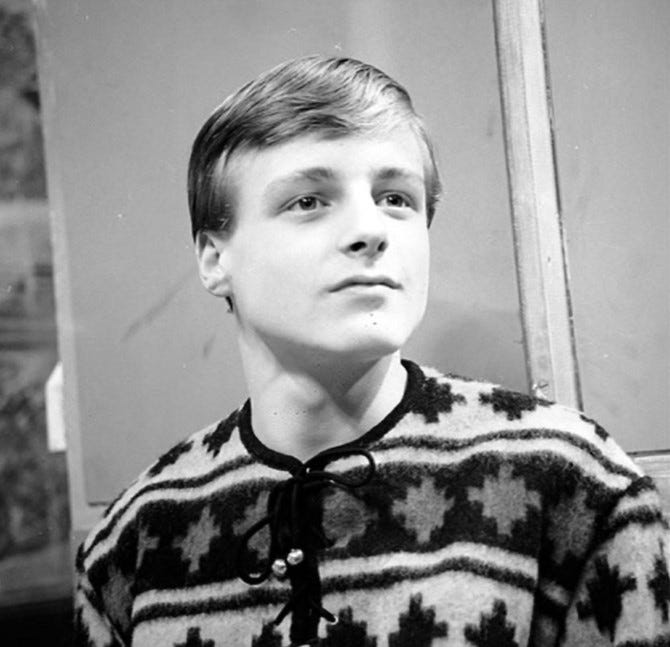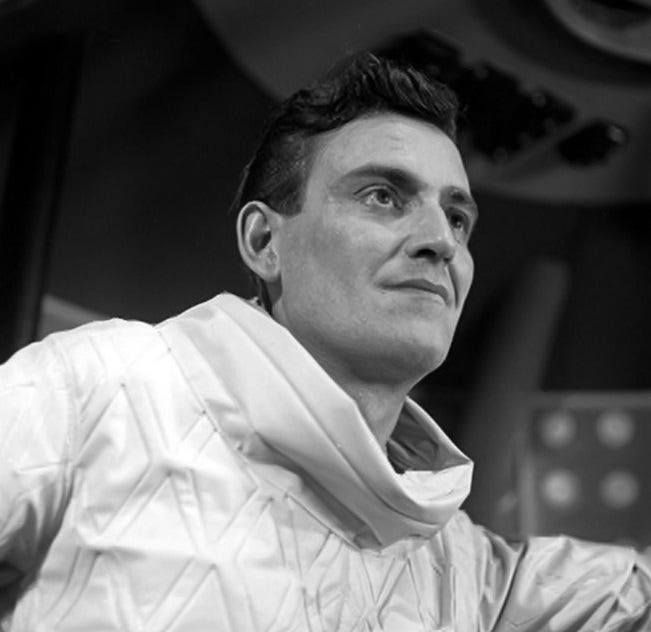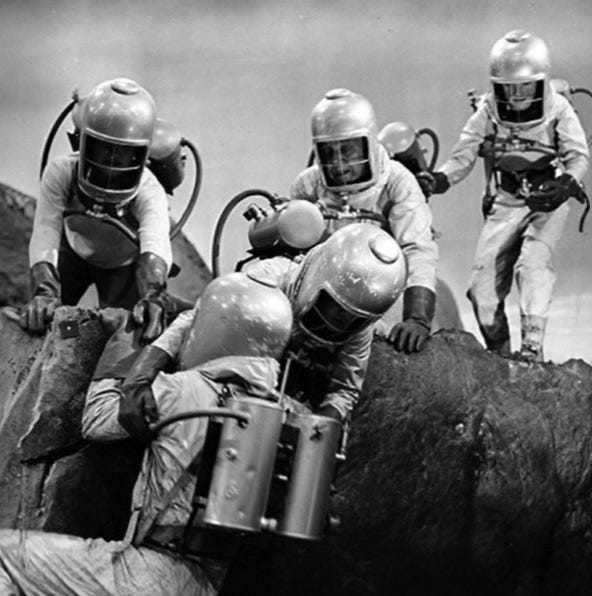Pathfinders to Doctor Who
I’ve recently enjoyed rewatching the three surviving Pathfinders children’s science fiction serials from 1960-61. These were produced by Sydney Newman for ITV company ABC and essentially became his blueprint for Doctor Who when, soon afterwards, he was poached by the BBC to be their head of drama.
The initial serial, Target Luna, saw 13-year-old Jimmy Wedgwood (whose brother Geoff was played in this serial by Michael Craze) being shot into lunar orbit in his father’s rocket when the designated pilot fell ill. In its first sequel, Pathfinders in Space, the whole Wedgwood family, plus assorted additions, visit the moon. The cast of space-farers was further rejigged for Pathfinders to Mars and Pathfinders to Venus, which had the revised crew visit our next nearest neighbours. Only Geoff (played by Stewart Guidotti since Pathfinders in Space) continued throughout the series.
Newman instructed that the series should have an educational element and the writers aimed for credible stories. This led to them largely avoiding the B-movie clichés of bug-eyed monsters and ray guns, just as Newman later stipulated Doctor Who should do (although he was ignored!). However, the dialogue could be didactic, with any opportunity taken for a spot of science to be explained to the younger characters, for the audience’s benefit.
The series’ moments of jeopardy tended to be provided by genuine hazards of space travel, such as electrical storms, asteroids, radiation, and the more basic privations of fuel, air and water. The moon was appropriately airless and barren, and the evident lack of low gravity was explained prosaically (if implausibly) as the result of the countering effect of the weighty spacesuits the characters wore. Magnet boots explained why the crew did not float freely while travelling through space in their rocket.
Where the limits of human knowledge were exceeded, the authors filled the gaps with speculation (sometimes informed speculation) and dramatic licence. The depiction of Mars included polar ice-caps, as water had long been theorised to exist there – and it now seems the writers were probably right on this count. They were wider of the mark in positing Martian rain storms, however. When it came to Venus, all the stops were pulled out; it was presented as a verdant world rich in giant diamonds and uranium.
Alien life did inevitably crop up. In a plotline reminiscent of Quatermass and the Pit, the space explorers find a calcified figure on the moon and a spaceship they theorize to be millions of years old, which they pinch. Mars is home to lichen, which attacks the crew in search of their water. Things are livelier still on Venus, with ape-people and a race of Cro-Magnon-like cave people, as well dinosaurs thanks to stop-motion footage imported from the 1955 Czech film Journey into Prehistory.
Even so, some of the dangers in the last two serials came from within, with an impostor amongst the rocket crew, who is revealed to be Harcourt Brown, a speculative-science writer. Brown was played by George Coulouris, who was later seen as Arbitan in The Keys of Marinus (although he was possibly prouder of his role in Citizen Kane). Brown lies repeatedly to get his way, and is wholly untrustworthy. He is without genuine malice but is single-minded and ruthless in his pursuit of his dream of meeting intelligent alien life, which he insists is to be found on Mars and then Venus, where he ultimately chooses to remain.
By Pathfinders to Mars and Venus, the line-up of main characters had settled as an intelligent 30-something man (science journalist Conway Henderson, played by Gerald Flood, later Doctor Who’s King John/Kamelion) and woman (selenologist Professor Meadows), the older, anti-heroic Brown, and two adolescents: teenager Geoff and Henderson’s young but intelligent niece Margaret. Broadly speaking, this line-up was transposed into Doctor Who by its team of creators – Newman himself, Donald Wilson and CE Webber.
Clearly Ian and Barbara are analogues of Henderson and Meadows respectively, while the original, antagonistic version of the Doctor recalls Brown. The child characters were initially omitted by Webber’s first format proposal but Newman himself insisted on the addition of a ‘kid’ character. Susan, who resulted, is a rough amalgamation of Geoff and precocious child Margaret.
In Pathfinders to Venus, while in orbit around Venus, Brown edits a tape recording of a radio message to push the crew into landing, which they hadn’t planned to do, as he is adamant there is life on the planet. Later he leads them towards what he believes is a Venusian city, although he is proved mistaken. We see something very similar in Doctor Who’s second serial, The Daleks, in which the Doctor endangers his companions with his subterfuge over the TARDIS fluid link to force them into an expedition to the mysterious city they have seen in the distance. Whether this was a coincidental similarity or a result of a suggestion by Newman is unknown.
Newman also carried over the educational remit of Pathfinders into Doctor Who. While Ian as a science teacher, and the Doctor as a scientist, could cover the scientific exposition, the addition of time travel to the format and the inclusion of a history teacher in Barbara enabled a degree of historical education to be incorporated also.
The Pathfinders episodes were usually 25 minutes long and the stories were told in serials of six to eight episodes, which was broadly the format Doctor Who adopted, although Doctor Who was initially produced as a continuing series whereas Pathfinders comprised four separate but linked serials. The penultimate Pathfinders to Venus episode was the subject of a study about children’s responses to television. Newman gave Verity Lambert a copy of the resulting report when he installed her as producer of Doctor Who so that she could learn from its findings.
All four Pathfinders serials (we count Target Lunar under that umbrella title) were written by Malcolm Hulke and Eric Paice. Paice never crossed paths with Doctor Who, but Hulke certainly did. Newman made Hulke aware that he was developing another science fiction series and Hulke put himself forward as a prospective writer for it. Hulke was commissioned to write ‘The Hidden Planet’ for the first season but this was ultimately written-off as unsuitable. He was finally successful in getting a Doctor Who story made with 1967’s The Faceless Ones, which he cowrote with David Ellis. Writing solo, he later contributed several stories in the early 1970s, starting with Doctor Who and the Silurians.
The eponymous reptiles of The Silurians (and those of its sequel, The Sea Devils) represent a civilisation that flourished on Earth before humanity evolved. It wasn’t Hulke’s first iteration of this concept. The calcified figure found on the moon in Pathfinders in Space was the remains of a member of a space-faring humanoid civilisation from Earth that pre-dated humanity, but wiped itself out in nuclear war.
Target Luna is missing from the archives but the rest of the Pathfinders saga exists on crude telerecordings – like much early Doctor Who. The surviving serials were released on DVD by Network in 2011. They make fascinating viewing for anyone familiar with the early years of Doctor Who. With Network now sadly defunct, the boxed set has gone out of print but for the moment remains easy to get hold of online. I recommend picking up a copy while you can.
Images © ABC / Studio Canal
This is a revised version of an article originally published in Panic Moon in October 2011.
Sources
Simon’s Guerrier’s biography of David Whitaker, David Whitaker in an Exciting Adventure with Television, which can be bought here.
Paul Hayes’s Pull to Open, which charts the initial creation of Doctor Who, and can be bought here.
Andrew Pixley’s ‘Series Guide’ booklet from Network’s 2011 Pathfinders in Space DVD set
Nasa’s report on ice on Mars here.









